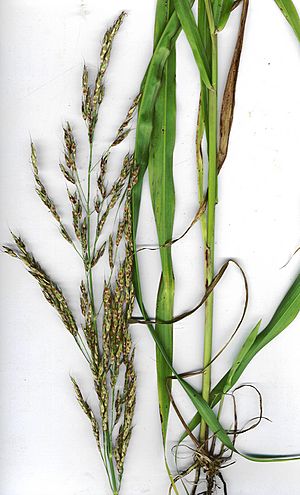Johnson grass facts for kids
Quick facts for kids Johnson grass(Sorghum halepense) |
|
|---|---|
 |
|
| Scientific classification | |
| Genus: |
Sorghum
|
| Species: |
halepense
|
Johnson grass or Johnsongrass, Sorghum halepense, is a plant that belongs to the grass family. It originally comes from Asia and northern Africa. This plant has now spread to almost every continent, except Antarctica. It grows and spreads using both underground stems called rhizomes and its seeds.
Johnson grass can be used to feed animals or to help stop erosion of soil. However, it is often seen as a weed because it can cause problems for farmers and animals.
Contents
Why Johnson Grass Can Be a Problem
Johnson grass can be a problem for several reasons:
- When the plant gets wilted from frost or very dry, hot weather, it can have a poison called hydrogen cyanide. If cattle or horses eat a lot of this wilted grass, it can make them very sick or even kill them.
- The plant can also cause 'bloat' in animals like cows. This happens when too many nitrates build up in the animal's stomach.
- It grows and spreads very quickly. This means it can take over fields and 'choke out' other important crops that farmers want to grow.
Where Johnson Grass Grows
You can find Johnson grass in many different places. It grows in farm fields, pastures, and areas where land has been left alone. It also grows along roadsides, at the edges of forests, and next to streams. This plant likes open, disturbed areas with rich soil, especially in fields that are farmed.
Some Johnson grass plants have become resistant to a common herbicide called glyphosate. This means the weed killer doesn't work on them anymore. These resistant plants have been found in countries like Argentina and the United States. Johnson grass is considered one of the ten worst weeds in the world. In the United States, many states list it as a harmful or controlled weed.
The History of Johnson Grass
This plant is named after Colonel William Johnson. He was a plantation owner in Alabama who planted its seeds around 1840. However, the plant was already growing in several US states about ten years before that. It was either brought in on purpose to be animal feed or accidentally mixed in with other seeds.
In the early 1900s, in Talladega County, people had mixed feelings about Johnson grass. Some thought it was good for feeding animals because it was nutritious and grew well. But many farmers still didn't like it because it could become too thick and stop growing new shoots unless the fields were plowed every few years.
Scientists have studied how Johnson grass spread in the United States. They found that it was first brought to the US in Alabama and North Carolina. They also found another time it was brought in, this time in Arizona. As railroads were built across the country, these different groups of Johnson grass started to mix, especially around Texas.
An old book from 1889, called The Useful Native Plants of Australia, describes Johnson grass. It says the plant is strong and grows tall, from two to ten feet high. When it's young, it's juicy and good for cattle, but sheep don't eat it as much. It also produces many seeds. Settlers in Australia thought it was a new plant there.
Images for kids
See also
 In Spanish: Sorgo de Alepo para niños
In Spanish: Sorgo de Alepo para niños


